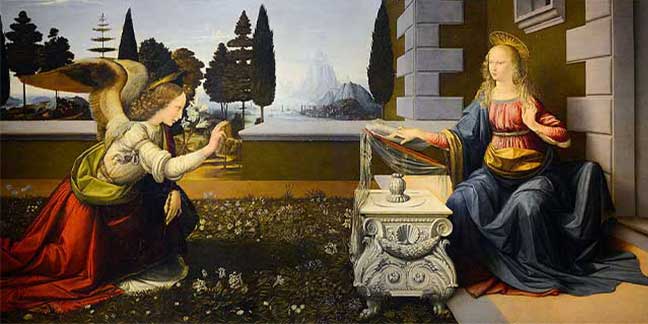Celebrated March 25
The Feast of the Annunciation celebrates the Incarnation of Our Savior – “the Word became flesh and dwelt among us” (John 1). God loved us so much that He chose to become one of us, taking on our humanity so completely that He became as utterly weak and dependent as an infant.
Our celebration of the Annunciation and the Incarnation affirms that human life begins at conception. God became man not with His birth nine months from now on Dec. 25, but at the moment of His conception in the womb of His mother, Mary. Thus the Feast of the Annunciation teaches us important lessons about the inestimable value God places on human life from the moment of conception. It also reminds us that although we understand best what we can see, the invisible, the hidden, is no less real for our lack of seeing it.
Try the beloved Catholic tradition of planting marigold seeds (named in honor of Mary) in your garden or in little pots on a window sill on the Feast of the Annunciation. Wait to see them sprout and grow. While you and your children are planting these seeds, talk about the importance of God’s “hidden” work. As a baby grows unseen within his mother’s womb, and as the sprouting seed invisibly grows under the soil, so is much essential and vital work people do not visible to most people, and may never be known except to God.
Further meditate on the beauty of the Annunciation by reading the Gospel of St. Luke 1:26-56, the Gospel of St. John Chapter 1, Psalm 139 or the Catechism of the Catholic Church 430-511.
— Sources: Diocese of Peoria Office of Respect Life and Human Dignity and the Respect Life Board; EWTN; Marian Devotions in the Domestic Church
Prayer for Life
O Mary, bright dawn of the new world, Mother of the living, to you do we entrust the cause of life: Look down, O Mother, upon the vast numbers of babies not allowed to be born, of the poor whose lives are made difficult, of men and women who are victims of brutal violence, of the elderly and the sick killed by indifference or out of misguided mercy. Grant that all who believe in your Son may proclaim the Gospel of life with honesty and love to the people of our time. Obtain for them the grace to accept that Gospel as a gift ever new, the joy of celebrating it with gratitude throughout their lives and the courage to bear witness to it resolutely, in order to build, together with all people of good will, the civilization of truth and love, to the praise and glory of God, the Creator and lover of life.
— St. John Paul II, from his encyclical “The Gospel of Life” (March 25,1995)
What’s the difference?
The virgin birth of Christ and the Immaculate Conception are sometimes confused as meaning the same thing, but that is incorrect. The dogma of the virgin birth states that Mary was a virgin before, during and after the conception and birth of Christ. The Immaculate Conception, however, concerns Mary’s conception without original sin. The Nicene Creed states Christ “came down from Heaven: by the power of the Holy Spirit He was born of the Virgin Mary, and became man.” Mary co-operated in the formation of Christ’s body as every mother co-operates in the formation of her child. This took place by the influence of the Holy Spirit. The Immaculate Conception refers to the belief that Mary was conceived free from original sin. In 1854, Pope Pius IX’s solemn declaration, “Ineffabilis Deus,” clarified this dogma.
In the words of the Catechism, “To become the mother of the Savior, Mary ‘was enriched by God with gifts appropriate to such a role.’ The angel Gabriel at the moment of the annunciation salutes her as ‘full of grace.’ In fact, for Mary to be able to give the free assent of her faith to the announcement of her vocation, it was necessary that she be wholly borne by God’s grace” (CCC 490).
— Source: www.newadvent.org



